Mary Quattlebaum's Blog, page 9
January 30, 2017
School's First Day of School
by Laura Gehl
School’s First Day of School, written by Adam Rex and illustrated by Christian Robinson, turns the typical “first day of school” story on its head. After a new school is built, makes friends with the janitor, and gets used to a peaceful existence, the school hears some scary, unwelcome news: children are coming!
 School’s First Day of Schoolwill be a fun writing prompt to use in the classroom. After you read the book aloud to your students, here are some activities to try:
School’s First Day of Schoolwill be a fun writing prompt to use in the classroom. After you read the book aloud to your students, here are some activities to try:
1. In this book, the main character is a school. If you were to write a story with an inanimate object as the main character, what object would you choose? Why? When you are choosing your object, think about what characteristics your inanimate object has that might be useful in the plot of your story. For example, in School’s First Day of School, the school is able to squirt a boy from a water fountain, be embarrassed by setting off the fire alarm, and be hurt by a pushpin. 2. What other books can you think of where the main character is an inanimate object? Make a list as a class.3. The school gradually warms up to the children, just as the little girl with freckles warms up to the school, and the book ends on a happy note. What if you were to write a sequel to School’s First Day of School? What would happen? What new problems would arise, and how would they be solved?
School’s First Day of School is funny, surprising, and heart-warming. It is a story of adapting to change, and of realizing that the things we never wanted may be exactly the things we need the most.
www.lauragehl.com
School’s First Day of School, written by Adam Rex and illustrated by Christian Robinson, turns the typical “first day of school” story on its head. After a new school is built, makes friends with the janitor, and gets used to a peaceful existence, the school hears some scary, unwelcome news: children are coming!
 School’s First Day of Schoolwill be a fun writing prompt to use in the classroom. After you read the book aloud to your students, here are some activities to try:
School’s First Day of Schoolwill be a fun writing prompt to use in the classroom. After you read the book aloud to your students, here are some activities to try:1. In this book, the main character is a school. If you were to write a story with an inanimate object as the main character, what object would you choose? Why? When you are choosing your object, think about what characteristics your inanimate object has that might be useful in the plot of your story. For example, in School’s First Day of School, the school is able to squirt a boy from a water fountain, be embarrassed by setting off the fire alarm, and be hurt by a pushpin. 2. What other books can you think of where the main character is an inanimate object? Make a list as a class.3. The school gradually warms up to the children, just as the little girl with freckles warms up to the school, and the book ends on a happy note. What if you were to write a sequel to School’s First Day of School? What would happen? What new problems would arise, and how would they be solved?
School’s First Day of School is funny, surprising, and heart-warming. It is a story of adapting to change, and of realizing that the things we never wanted may be exactly the things we need the most.
www.lauragehl.com
Published on January 30, 2017 14:00
January 23, 2017
Writing Connections with Raina Telgemeier
by Mary Quattlebaum
 Is the classroom or your personal journaling experience starting to pall? One way to spice up the journal-keeping process is to add visuals. That’s how Raina Telgemeier got her start as a graphic novelist when she was 10 years old. In a recent interview in the KidsPost section of the Washington Post, Raina talks about her newest graphic novel
Ghosts
and how she began keeping a comics diary when she was a kid.
Is the classroom or your personal journaling experience starting to pall? One way to spice up the journal-keeping process is to add visuals. That’s how Raina Telgemeier got her start as a graphic novelist when she was 10 years old. In a recent interview in the KidsPost section of the Washington Post, Raina talks about her newest graphic novel
Ghosts
and how she began keeping a comics diary when she was a kid.
Below are writing lessons for the classroom or for individual writers ages 8 and up. Telgemeir’s website also has teacher’s guides.
WRITING/DRAWING YOUR LIFE: Classroom Discussion, Part 1: You might start by showing kids various examples of graphic novels (Telgemeier’s Smile, Sisters and Ghosts; Jennifer Holm’s Babymouse series, Gene Yang’s Secret Coders series). Though most tell a fictional story, Smile and Sisters chronicle events in Telgemeier’s life.
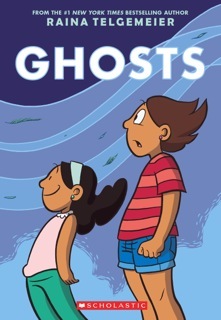
Classroom Writing: Instead of the usual journaling-in-words-only that is done as part of the classroom writing experience, encourage students to do what Telgemeir did as a kid. In a “comics diary,” she recorded her days in comic-strip form. This loose, sketchy process helps kids to avoid getting hung up on creating “realistic” drawings and instead encourages them to focus on what’s key to the day/emotion/scene in very stylized drawings. Students might do just one panel with dialogue balloons that captures an experience or several linked ones.
You might also have them bring photos from home or have some magazines on hand so they might cut and paste in backgrounds, relevant images, etc.
Examples of Prompts (these also work for traditional journal entries): What made me scared today? Angry? Excited? Annoyed? Happy? Before writing, have students close their eyes and focus on their day and call a particular emotion/event to mind.
Classroom Discussion, Part 2: After about a week of keeping a comics journal, ask students which they preferred, comics journal or the more traditional writing journal. Or perhaps a combination. What did they like/dislike about all three? What did they enjoy/learn from the comics diary experience? Did doing their own comics diaries change the way they looked at/read graphic novels?
www.maryquattlebaum.com
 Is the classroom or your personal journaling experience starting to pall? One way to spice up the journal-keeping process is to add visuals. That’s how Raina Telgemeier got her start as a graphic novelist when she was 10 years old. In a recent interview in the KidsPost section of the Washington Post, Raina talks about her newest graphic novel
Ghosts
and how she began keeping a comics diary when she was a kid.
Is the classroom or your personal journaling experience starting to pall? One way to spice up the journal-keeping process is to add visuals. That’s how Raina Telgemeier got her start as a graphic novelist when she was 10 years old. In a recent interview in the KidsPost section of the Washington Post, Raina talks about her newest graphic novel
Ghosts
and how she began keeping a comics diary when she was a kid.Below are writing lessons for the classroom or for individual writers ages 8 and up. Telgemeir’s website also has teacher’s guides.
WRITING/DRAWING YOUR LIFE: Classroom Discussion, Part 1: You might start by showing kids various examples of graphic novels (Telgemeier’s Smile, Sisters and Ghosts; Jennifer Holm’s Babymouse series, Gene Yang’s Secret Coders series). Though most tell a fictional story, Smile and Sisters chronicle events in Telgemeier’s life.

Classroom Writing: Instead of the usual journaling-in-words-only that is done as part of the classroom writing experience, encourage students to do what Telgemeir did as a kid. In a “comics diary,” she recorded her days in comic-strip form. This loose, sketchy process helps kids to avoid getting hung up on creating “realistic” drawings and instead encourages them to focus on what’s key to the day/emotion/scene in very stylized drawings. Students might do just one panel with dialogue balloons that captures an experience or several linked ones.
You might also have them bring photos from home or have some magazines on hand so they might cut and paste in backgrounds, relevant images, etc.
Examples of Prompts (these also work for traditional journal entries): What made me scared today? Angry? Excited? Annoyed? Happy? Before writing, have students close their eyes and focus on their day and call a particular emotion/event to mind.
Classroom Discussion, Part 2: After about a week of keeping a comics journal, ask students which they preferred, comics journal or the more traditional writing journal. Or perhaps a combination. What did they like/dislike about all three? What did they enjoy/learn from the comics diary experience? Did doing their own comics diaries change the way they looked at/read graphic novels?
www.maryquattlebaum.com
Published on January 23, 2017 14:00
January 16, 2017
All Dogs Must Go!
by Karen Leggett Abouraya
All the dogs at the shelter must be adopted before closing day. Will that include Spanky the pup with three legs?
This short story will pull at your heartstrings and provide many opportunities to get young children or teens talking, thinking and writing.
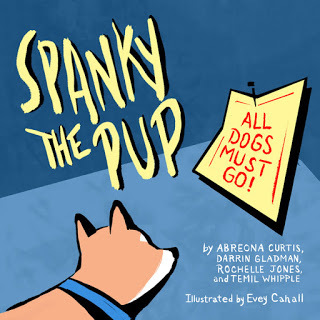
Spanky the Pup was written by Abreona Curtis, Darrin Gladman, Rochelle Jones and Temil Whipple, illustrated by Evey Cahall. That’s right – a team of writers. All teenagers themselves, all working with Shout Mouse Press, a nonprofit writing program and publishing house. As it says in each published book, “Shout Mouse Press empowers writers from marginalized communities to tell their own stories in their own voices and act as agents of change.”
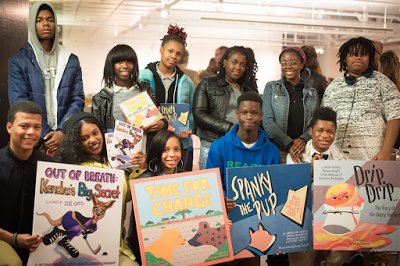 Photo credit: Reach Incorporated
Photo credit: Reach Incorporated
Shout Mouse Press partnered with another nonprofit, Reach Incorporated, to help teens in Washington, D.C., write their own stories for young children. The teens were challenged to write original, inclusive stories that would reflect the realities of their own communities.
Four new titles were published in November 2016: Time for Change: The Lionand Hyena Story Drip Drip: The Story of the Angry Sherbet Out of Breath: Kendra’s Big Secret Spanky the Pup
The books may be shared with older students as a project they could replicate. Students of any age can use the books to spark discussion and writing.
Let’s take Spanky, the pup with three legs who fears he will be left out on the final day of adoptions. Spanky’s story may help children talk or write about a sensitive topic.
· What did the dog named Dorothy do to help Spanky (defended him, built up his confidence)?
· Write about an experience when you felt left out. What do you wish someone had done to help? How could you help make sure someone else doesn’t feel left out?
· What can you say when you see someone being unkind or hurting someone else with their words?
· What are ways to act with kindness at home or at school?
As a writing style, it is also possible to talk about the ending of this story which is shown entirely in pictures without a single word. No spoiler alert here…
Shout Mouse Press would like to know how you use the books written by these teen authors with students. Please share your projects with kathyATshoutmousepress.org.
http://childrensbookguild.org/karen-leggett-abouraya
All the dogs at the shelter must be adopted before closing day. Will that include Spanky the pup with three legs?
This short story will pull at your heartstrings and provide many opportunities to get young children or teens talking, thinking and writing.

Spanky the Pup was written by Abreona Curtis, Darrin Gladman, Rochelle Jones and Temil Whipple, illustrated by Evey Cahall. That’s right – a team of writers. All teenagers themselves, all working with Shout Mouse Press, a nonprofit writing program and publishing house. As it says in each published book, “Shout Mouse Press empowers writers from marginalized communities to tell their own stories in their own voices and act as agents of change.”
 Photo credit: Reach Incorporated
Photo credit: Reach IncorporatedShout Mouse Press partnered with another nonprofit, Reach Incorporated, to help teens in Washington, D.C., write their own stories for young children. The teens were challenged to write original, inclusive stories that would reflect the realities of their own communities.
Four new titles were published in November 2016: Time for Change: The Lionand Hyena Story Drip Drip: The Story of the Angry Sherbet Out of Breath: Kendra’s Big Secret Spanky the Pup
The books may be shared with older students as a project they could replicate. Students of any age can use the books to spark discussion and writing.
Let’s take Spanky, the pup with three legs who fears he will be left out on the final day of adoptions. Spanky’s story may help children talk or write about a sensitive topic.
· What did the dog named Dorothy do to help Spanky (defended him, built up his confidence)?
· Write about an experience when you felt left out. What do you wish someone had done to help? How could you help make sure someone else doesn’t feel left out?
· What can you say when you see someone being unkind or hurting someone else with their words?
· What are ways to act with kindness at home or at school?
As a writing style, it is also possible to talk about the ending of this story which is shown entirely in pictures without a single word. No spoiler alert here…
Shout Mouse Press would like to know how you use the books written by these teen authors with students. Please share your projects with kathyATshoutmousepress.org.
http://childrensbookguild.org/karen-leggett-abouraya
Published on January 16, 2017 14:00
January 9, 2017
WHAT IS NORMAL?
by Jacqueline Jules
Bullying is an ongoing problem in all schools. Taking a little time to write and think about what exactly is “normal” might go a long way to defuse the primary source of the issue. Students are bullied for being “different.” Yet the criteria for being “different” varies from one community to another. A child from Latin America may be considered “different” in a small town in the midwest. While a child from a farm might be misunderstood in a metropolitan city. Tara Lazar’s Normal Norman can be a great discussion starter for this topic.
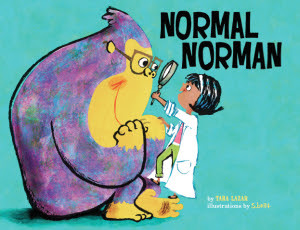
In this picture book, a child scientist tries to demonstrate how “normal” a purple orangutan named Norman is. Yet it turns out that Norman sleeps in a bed with a stuffed animal and likes pizza better than bananas. One revelation after another demonstrates that Norman’s behavior is not what is expected for an orangutan. The young scientist is distraught. Norman’s abnormally large heart and breezy acceptance of himself saves the day as the young scientist finally accepts that “normal” cannot be defined.
After reading Normal Norman, discuss why it is so difficult to define “normal.” Does everyone have the same body type, eating habits, or sleep patterns? Are members of the same family exactly the same? Would you even want them to be? Would you want to spend the day in a classroom of “normal” students exactly alike? Do a ten minute quick write. Can you describe what a typical school day would be like if everyone looked and behaved the same way? For added inspiration, you could read a short passage from A Wrinkle in Time by Madeleine L’Engle describing the planet where all the children behave in a mechanistic way, like robots.
Next, provide your students with a dictionary definition of “normal,” meaning ordinary, standard, typical, etc. Contrast that to the definition of “unique” meaning unusual or special, unlike anything else. Ask your students to write a short essay on the topic. Would you prefer to be “normal” or “unique?” What are the advantages and disadvantages of each?
What’s normal for one person or family does not suit another. We are indeed all different. Normal Norman celebrates individuality, an important topic to think and write about.
www.jacquelinejules.com
Bullying is an ongoing problem in all schools. Taking a little time to write and think about what exactly is “normal” might go a long way to defuse the primary source of the issue. Students are bullied for being “different.” Yet the criteria for being “different” varies from one community to another. A child from Latin America may be considered “different” in a small town in the midwest. While a child from a farm might be misunderstood in a metropolitan city. Tara Lazar’s Normal Norman can be a great discussion starter for this topic.

In this picture book, a child scientist tries to demonstrate how “normal” a purple orangutan named Norman is. Yet it turns out that Norman sleeps in a bed with a stuffed animal and likes pizza better than bananas. One revelation after another demonstrates that Norman’s behavior is not what is expected for an orangutan. The young scientist is distraught. Norman’s abnormally large heart and breezy acceptance of himself saves the day as the young scientist finally accepts that “normal” cannot be defined.
After reading Normal Norman, discuss why it is so difficult to define “normal.” Does everyone have the same body type, eating habits, or sleep patterns? Are members of the same family exactly the same? Would you even want them to be? Would you want to spend the day in a classroom of “normal” students exactly alike? Do a ten minute quick write. Can you describe what a typical school day would be like if everyone looked and behaved the same way? For added inspiration, you could read a short passage from A Wrinkle in Time by Madeleine L’Engle describing the planet where all the children behave in a mechanistic way, like robots.
Next, provide your students with a dictionary definition of “normal,” meaning ordinary, standard, typical, etc. Contrast that to the definition of “unique” meaning unusual or special, unlike anything else. Ask your students to write a short essay on the topic. Would you prefer to be “normal” or “unique?” What are the advantages and disadvantages of each?
What’s normal for one person or family does not suit another. We are indeed all different. Normal Norman celebrates individuality, an important topic to think and write about.
www.jacquelinejules.com
Published on January 09, 2017 14:00
December 19, 2016
Handmade Accordion Journals
by Joan Waites
An easy but elegant gift to give to the writers and artists in your life is a handmade accordion journal. Using a few simple materials and your own personalization, these journals can be left blank for the recipient to write or draw and paint in, or you can fill it with your own memories, poems, stories or art.
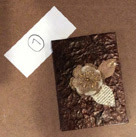
You will need: 1. Two identical rectangles or squares of cardboard cut to any size. Cut up cereal boxes or gift boxes work well.
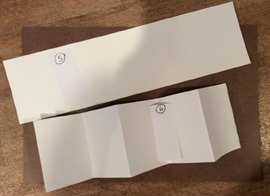
2. Craft or brown paper (lunch bags, grocery bags or package paper)3. Large sheet of heavyweight paper (watercolor paper or mixed media paper)4. Glue or Mod Podge5. Black acrylic paint (available in craft stores in small bottles)6. Metallic paint in color of your choice (available in craft stores in small bottles)7. Any embellishments you want to use for the cover (Silk flowers, beads, metal embellishments etc.)

Start by covering your two cardboard pieces with torn pieces of craft or brown paper and glue flat. These will be used for the front and back cover of the journal. When dry, paint the covers first in black acrylic paint, and when dry, cover over black in metallic paint. Next, cut a long strip of watercolor or other heavy weight paper. This should be slightly smaller in size than the height and width of the covers. Fold the paper back and forth in an accordion fold so it will fit inside each cover. Glue the first and last pages of your blank paper to the inside of the front and back covers. Place completed journal under something heavy overnight to flatten out pages. If desired, add your own touch to the inside or leave blank. Decorate front cover with embellishments.
Wishing all our readers a very happy holiday season and all the best for the coming year!
www.joanwaites.com
An easy but elegant gift to give to the writers and artists in your life is a handmade accordion journal. Using a few simple materials and your own personalization, these journals can be left blank for the recipient to write or draw and paint in, or you can fill it with your own memories, poems, stories or art.

You will need: 1. Two identical rectangles or squares of cardboard cut to any size. Cut up cereal boxes or gift boxes work well.

2. Craft or brown paper (lunch bags, grocery bags or package paper)3. Large sheet of heavyweight paper (watercolor paper or mixed media paper)4. Glue or Mod Podge5. Black acrylic paint (available in craft stores in small bottles)6. Metallic paint in color of your choice (available in craft stores in small bottles)7. Any embellishments you want to use for the cover (Silk flowers, beads, metal embellishments etc.)

Start by covering your two cardboard pieces with torn pieces of craft or brown paper and glue flat. These will be used for the front and back cover of the journal. When dry, paint the covers first in black acrylic paint, and when dry, cover over black in metallic paint. Next, cut a long strip of watercolor or other heavy weight paper. This should be slightly smaller in size than the height and width of the covers. Fold the paper back and forth in an accordion fold so it will fit inside each cover. Glue the first and last pages of your blank paper to the inside of the front and back covers. Place completed journal under something heavy overnight to flatten out pages. If desired, add your own touch to the inside or leave blank. Decorate front cover with embellishments.
Wishing all our readers a very happy holiday season and all the best for the coming year!
www.joanwaites.com
Published on December 19, 2016 14:00
December 12, 2016
The Power (and Art) of Dissent
Guest Post by Debbie Levy
I Dissent: Ruth Bader Ginsburg Makes Her Mark tells the story of Ruth Bader Ginsburg’s life and work through the lens of her many disagreements and dissents, ever since she was a little girl. The book illuminates this central theme: disagreeing does not make you disagreeable, and important change happens one disagreement at a time.
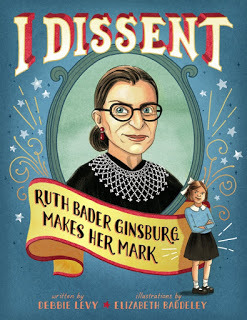
I think that RBG is such a fine example to hold up for our children. She’s a person who has been a change-maker and path-breaker through her disagreements. As importantly, her example shows that one can disagree and make big change happen without resorting to personal attacks, without insulting your opponents, and without closing yourself off to opposing points of view. A variation on the “I dissent” theme appears on nearly every spread in the book:· “She protested” (as a schoolgirl, to being forced to write with her right hand even though she is left-handed). · “Ruth objected” (also in school, to the rule that required girls to take home ec, reserving shop class for boys). · “Ruth disapproved right back” (when people disapproved of her decision to go to law school). · “She resisted. And persisted” (when, as a young law school graduate at the top of her class, no one would hire her because she was a woman, a mother, and a Jew). And so on. Today, of course, she is United States Supreme Court Justice Ruth Bader Ginsburg—and she is still known for her dissents from court rulings that she considers wrongly decided. But simply disagreeing or dissenting, without more, isn’t really enough if you want to change your life or anyone else’s. On the back of book jacket for I Dissent, there’s this, one of my favorite RBG quotes: “Fight for the things that you care about. But do it in a way that will lead others to join you.” Sounds simple, right? But it’s that second sentence that is so hard to pull off. And here is where educators (and parents and other adults) can help children discover the power of dissent and of persuasive argument.
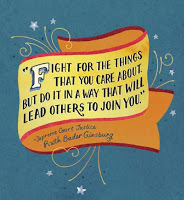
First , we can use the language of I Dissent to broaden students’ vocabulary of disagreement. I’m talking about words like: accept - protest - support - disagree - object - defend - resist - approve - concur - differ -dissent - agree
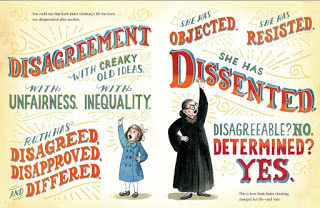
Students can start by putting these words on a continuum—or a “semantic gradient.” (I am indebted for this idea to Myra Zarnowski, professor in the Department of Elementary and Early Childhood Education at Queens College, CUNY, who includes it in the I Dissent Curriculum Guide she wrote for my publisher, Simon & Schuster.) “Agree” can be on one end of the gradient; “dissent” on the other. There is no single correct way to array these words! But this is a good way to get kids talking about the shades of meaning in words that we often use interchangeably, or as opposites.
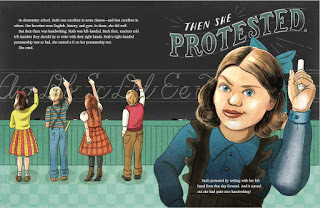 Second
, we can use the themes of I Dissent to help develop students’ skills at engaging in effective and appropriate disagreement. I’ve had fun with third and fourth graders by having them take on the proposition:
You should only be allowed to play video games after school once you’ve finished your homework
. Most kids seem to dissent! So they make their case for taking time to relax before doing their homework. And they practice the elements of effective arguing, like:· presenting ideas that they’ve thought through—not just “because I want to”· having facts and evidence to back up what they’re saying· disagreeing respectfully, without attacking the person who holds opposing ideas
Third
, we can use RBG’s example to discuss—and write about—when the expression of disagreement is most important, and when expressions of disagreement may be more hurtful than helpful. Ask students to respond to this question:
When have you seen or heard something that you disagreed with, that you either challenged or wanted to challenge?
The idea here is to encourage young writers to think about speaking out when they see bullying, or when they’re told to do something they think is wrong, or when someone says something about another person that they believe is untrue. Let’s also get them thinking about when a disagreement isn’t important enough to voice, especially if it might be hurtful—such as disagreement with another’s choice of clothing or what’s in their lunchbox.
And fourth
, readers of I Dissent will notice that RBG did not succeed at everything she tried. She has had setbacks and failures. Ask students to think about their own setbacks, and to write about what they learned from their failures. Everyone has them. What can young writers do with theirs?
Second
, we can use the themes of I Dissent to help develop students’ skills at engaging in effective and appropriate disagreement. I’ve had fun with third and fourth graders by having them take on the proposition:
You should only be allowed to play video games after school once you’ve finished your homework
. Most kids seem to dissent! So they make their case for taking time to relax before doing their homework. And they practice the elements of effective arguing, like:· presenting ideas that they’ve thought through—not just “because I want to”· having facts and evidence to back up what they’re saying· disagreeing respectfully, without attacking the person who holds opposing ideas
Third
, we can use RBG’s example to discuss—and write about—when the expression of disagreement is most important, and when expressions of disagreement may be more hurtful than helpful. Ask students to respond to this question:
When have you seen or heard something that you disagreed with, that you either challenged or wanted to challenge?
The idea here is to encourage young writers to think about speaking out when they see bullying, or when they’re told to do something they think is wrong, or when someone says something about another person that they believe is untrue. Let’s also get them thinking about when a disagreement isn’t important enough to voice, especially if it might be hurtful—such as disagreement with another’s choice of clothing or what’s in their lunchbox.
And fourth
, readers of I Dissent will notice that RBG did not succeed at everything she tried. She has had setbacks and failures. Ask students to think about their own setbacks, and to write about what they learned from their failures. Everyone has them. What can young writers do with theirs?
 Debbie Levy is the award-winning author of nonfiction and fiction books for young people, including I Dissent: Ruth Bader Ginsburg Makes Her Mark; We Shall Overcome: The Story of a Song; The Year of Goodbyes: A True Story of Friendship, Family, and Farewells; and Dozer’s Run: A True Story of a Dog and His Race. Debbie’s next book, Soldier Song: A True Story of the Civil War, is an 80-page picture book for older children about how music, and one song in particular, brought the two sides of the struggle together for one night, enabling the soldiers to see the other side—the enemy—as fellow human beings. It comes out in February 2017. Visit her online at debbielevybooks.com
Debbie Levy is the award-winning author of nonfiction and fiction books for young people, including I Dissent: Ruth Bader Ginsburg Makes Her Mark; We Shall Overcome: The Story of a Song; The Year of Goodbyes: A True Story of Friendship, Family, and Farewells; and Dozer’s Run: A True Story of a Dog and His Race. Debbie’s next book, Soldier Song: A True Story of the Civil War, is an 80-page picture book for older children about how music, and one song in particular, brought the two sides of the struggle together for one night, enabling the soldiers to see the other side—the enemy—as fellow human beings. It comes out in February 2017. Visit her online at debbielevybooks.com
I Dissent: Ruth Bader Ginsburg Makes Her Mark tells the story of Ruth Bader Ginsburg’s life and work through the lens of her many disagreements and dissents, ever since she was a little girl. The book illuminates this central theme: disagreeing does not make you disagreeable, and important change happens one disagreement at a time.

I think that RBG is such a fine example to hold up for our children. She’s a person who has been a change-maker and path-breaker through her disagreements. As importantly, her example shows that one can disagree and make big change happen without resorting to personal attacks, without insulting your opponents, and without closing yourself off to opposing points of view. A variation on the “I dissent” theme appears on nearly every spread in the book:· “She protested” (as a schoolgirl, to being forced to write with her right hand even though she is left-handed). · “Ruth objected” (also in school, to the rule that required girls to take home ec, reserving shop class for boys). · “Ruth disapproved right back” (when people disapproved of her decision to go to law school). · “She resisted. And persisted” (when, as a young law school graduate at the top of her class, no one would hire her because she was a woman, a mother, and a Jew). And so on. Today, of course, she is United States Supreme Court Justice Ruth Bader Ginsburg—and she is still known for her dissents from court rulings that she considers wrongly decided. But simply disagreeing or dissenting, without more, isn’t really enough if you want to change your life or anyone else’s. On the back of book jacket for I Dissent, there’s this, one of my favorite RBG quotes: “Fight for the things that you care about. But do it in a way that will lead others to join you.” Sounds simple, right? But it’s that second sentence that is so hard to pull off. And here is where educators (and parents and other adults) can help children discover the power of dissent and of persuasive argument.

First , we can use the language of I Dissent to broaden students’ vocabulary of disagreement. I’m talking about words like: accept - protest - support - disagree - object - defend - resist - approve - concur - differ -dissent - agree

Students can start by putting these words on a continuum—or a “semantic gradient.” (I am indebted for this idea to Myra Zarnowski, professor in the Department of Elementary and Early Childhood Education at Queens College, CUNY, who includes it in the I Dissent Curriculum Guide she wrote for my publisher, Simon & Schuster.) “Agree” can be on one end of the gradient; “dissent” on the other. There is no single correct way to array these words! But this is a good way to get kids talking about the shades of meaning in words that we often use interchangeably, or as opposites.
 Second
, we can use the themes of I Dissent to help develop students’ skills at engaging in effective and appropriate disagreement. I’ve had fun with third and fourth graders by having them take on the proposition:
You should only be allowed to play video games after school once you’ve finished your homework
. Most kids seem to dissent! So they make their case for taking time to relax before doing their homework. And they practice the elements of effective arguing, like:· presenting ideas that they’ve thought through—not just “because I want to”· having facts and evidence to back up what they’re saying· disagreeing respectfully, without attacking the person who holds opposing ideas
Third
, we can use RBG’s example to discuss—and write about—when the expression of disagreement is most important, and when expressions of disagreement may be more hurtful than helpful. Ask students to respond to this question:
When have you seen or heard something that you disagreed with, that you either challenged or wanted to challenge?
The idea here is to encourage young writers to think about speaking out when they see bullying, or when they’re told to do something they think is wrong, or when someone says something about another person that they believe is untrue. Let’s also get them thinking about when a disagreement isn’t important enough to voice, especially if it might be hurtful—such as disagreement with another’s choice of clothing or what’s in their lunchbox.
And fourth
, readers of I Dissent will notice that RBG did not succeed at everything she tried. She has had setbacks and failures. Ask students to think about their own setbacks, and to write about what they learned from their failures. Everyone has them. What can young writers do with theirs?
Second
, we can use the themes of I Dissent to help develop students’ skills at engaging in effective and appropriate disagreement. I’ve had fun with third and fourth graders by having them take on the proposition:
You should only be allowed to play video games after school once you’ve finished your homework
. Most kids seem to dissent! So they make their case for taking time to relax before doing their homework. And they practice the elements of effective arguing, like:· presenting ideas that they’ve thought through—not just “because I want to”· having facts and evidence to back up what they’re saying· disagreeing respectfully, without attacking the person who holds opposing ideas
Third
, we can use RBG’s example to discuss—and write about—when the expression of disagreement is most important, and when expressions of disagreement may be more hurtful than helpful. Ask students to respond to this question:
When have you seen or heard something that you disagreed with, that you either challenged or wanted to challenge?
The idea here is to encourage young writers to think about speaking out when they see bullying, or when they’re told to do something they think is wrong, or when someone says something about another person that they believe is untrue. Let’s also get them thinking about when a disagreement isn’t important enough to voice, especially if it might be hurtful—such as disagreement with another’s choice of clothing or what’s in their lunchbox.
And fourth
, readers of I Dissent will notice that RBG did not succeed at everything she tried. She has had setbacks and failures. Ask students to think about their own setbacks, and to write about what they learned from their failures. Everyone has them. What can young writers do with theirs? Debbie Levy is the award-winning author of nonfiction and fiction books for young people, including I Dissent: Ruth Bader Ginsburg Makes Her Mark; We Shall Overcome: The Story of a Song; The Year of Goodbyes: A True Story of Friendship, Family, and Farewells; and Dozer’s Run: A True Story of a Dog and His Race. Debbie’s next book, Soldier Song: A True Story of the Civil War, is an 80-page picture book for older children about how music, and one song in particular, brought the two sides of the struggle together for one night, enabling the soldiers to see the other side—the enemy—as fellow human beings. It comes out in February 2017. Visit her online at debbielevybooks.com
Debbie Levy is the award-winning author of nonfiction and fiction books for young people, including I Dissent: Ruth Bader Ginsburg Makes Her Mark; We Shall Overcome: The Story of a Song; The Year of Goodbyes: A True Story of Friendship, Family, and Farewells; and Dozer’s Run: A True Story of a Dog and His Race. Debbie’s next book, Soldier Song: A True Story of the Civil War, is an 80-page picture book for older children about how music, and one song in particular, brought the two sides of the struggle together for one night, enabling the soldiers to see the other side—the enemy—as fellow human beings. It comes out in February 2017. Visit her online at debbielevybooks.com
Published on December 12, 2016 14:00
December 5, 2016
Writing with The Maple book series
by Laura Gehl
The Maple books by Lori Nichols feature Maple, a nature-loving, spirited little girl, and her younger sister Willow. The series begins with Maple, followed by Maple and Willow Together, and then Maple and Willow Apart.
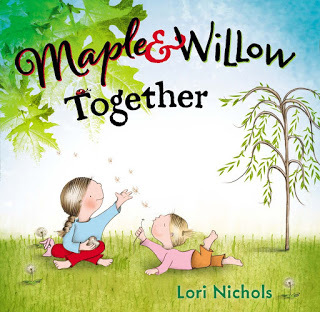
The Maple books make a great writing prompt for the classroom. After you read the books aloud, here are a few ways to use this heart-filled trio of picture books with your students:
1) Which of the three books in the Mapleseries is your favorite? Why?2) Maple and Willow are both named after trees. What if you had to pick a name for yourself that is the name of a tree, flower, bird, or rock? What name would you pick? Why? 3) In Maple and Willow Together, Maple and Willow have a huge fight that starts over something silly—whether to keep their dandelions or blow the seeds. Write about a time you had a fight with a friend or family member over something silly. How did you work things out in the end?4) In Maple and Willow Apart, Maple and Willow figure out a way to stay connected even when Maple is at school and Willow is at home: Maple carries an acorn from Willow with her to school. Think about someone you love who lives in a different city or state—a grandparent, a cousin, or maybe a friend who has moved away. How do you stay connected to this person when you can’t be in the same place?
The Maple books are about sisters, but they resonate with every reader, whether the child has a sister or not. This is because these books touch on essential truths of every relationship, showing how our important relationships grow and change over time, that there are always bumps along the way, and that we can find ways to stay close to people we love even when we can’t be with them all the time.
www.lauragehl.com
The Maple books by Lori Nichols feature Maple, a nature-loving, spirited little girl, and her younger sister Willow. The series begins with Maple, followed by Maple and Willow Together, and then Maple and Willow Apart.

The Maple books make a great writing prompt for the classroom. After you read the books aloud, here are a few ways to use this heart-filled trio of picture books with your students:
1) Which of the three books in the Mapleseries is your favorite? Why?2) Maple and Willow are both named after trees. What if you had to pick a name for yourself that is the name of a tree, flower, bird, or rock? What name would you pick? Why? 3) In Maple and Willow Together, Maple and Willow have a huge fight that starts over something silly—whether to keep their dandelions or blow the seeds. Write about a time you had a fight with a friend or family member over something silly. How did you work things out in the end?4) In Maple and Willow Apart, Maple and Willow figure out a way to stay connected even when Maple is at school and Willow is at home: Maple carries an acorn from Willow with her to school. Think about someone you love who lives in a different city or state—a grandparent, a cousin, or maybe a friend who has moved away. How do you stay connected to this person when you can’t be in the same place?
The Maple books are about sisters, but they resonate with every reader, whether the child has a sister or not. This is because these books touch on essential truths of every relationship, showing how our important relationships grow and change over time, that there are always bumps along the way, and that we can find ways to stay close to people we love even when we can’t be with them all the time.
www.lauragehl.com
Published on December 05, 2016 14:00
November 28, 2016
IF YOU COULD HAVE A SUPERPOWER
by Jacqueline Jules
I am excited to announce that Freddie Ramos Rules New York was released in October 2016. This book is the sixth in the Zapato Power series about Freddie Ramos, the boy with super-powered purple sneakers.
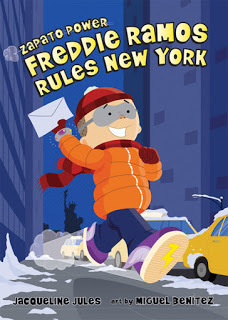
In Freddie’s newest adventure, he outgrows his special sneakers and must adjust to a larger pair. But will his new shoes work as well as his old ones? Freddie contemplates the possibilities during a bus ride to New York.
Uh-oh! Did my new zapatos give me super hearing? What about super speed? And super bounce? Could they do all three? I had two buttons on my wristband. What if two powers was all I got? Which ones did I want the most? Super hearing would be good when I wanted to hear what grown-ups were saying. Would I like it as much as running fast? I had to get off the bus and find out what my new shoes could do! But I was stuck in the window seat, watching more brown fields and buildings go by. How much longer till New York?
The inspiration for the Zapato Power series came from students when I worked as an elementary school librarian. My students never tired of discussing their favorite superpower and the requests for books on superheroes never stopped. The interest was especially intense when I shared Margaret Mahy’s The Seven Chinese Brothers in story time. This traditional tale is about seven identical brothers who each have a special skill. One brother has super strength. Another brother has super sight and so forth. My students and I had many lively conversations over which brother had the best super skill. The process of choosing one superpower over another can develop critical thinking skills. Ask your students to write pros and cons for a list of selected superpowers. This can lead to a persuasive writing exercise in which students explain why the superpower of their choice is the most useful and effective for their particular needs. A high interest topic like this can motivate even the most reluctant of writers. In the Zapato Power books, Freddie Ramos has trouble navigating the ordinary world with his superpowers. Ask your students to write about how they think their lives might change if they had super speed or super hearing. What kind of challenges might they face? Would it be difficult to keep your superpower a secret? Would you be tempted to eavesdrop on your friends or use super speed to an unfair advantage in athletic events? Ask your students to really examine how they would use their superpower and when.
There are many questions to consider. Would you try to stop bullies and make the world a better place? Would you enjoy doing good deeds if no one knew you were responsible? A list of writing prompts are available on this page of the Zapato Power Activity Guide. Enjoy!

www.jacquelinejules.com
I am excited to announce that Freddie Ramos Rules New York was released in October 2016. This book is the sixth in the Zapato Power series about Freddie Ramos, the boy with super-powered purple sneakers.

In Freddie’s newest adventure, he outgrows his special sneakers and must adjust to a larger pair. But will his new shoes work as well as his old ones? Freddie contemplates the possibilities during a bus ride to New York.
Uh-oh! Did my new zapatos give me super hearing? What about super speed? And super bounce? Could they do all three? I had two buttons on my wristband. What if two powers was all I got? Which ones did I want the most? Super hearing would be good when I wanted to hear what grown-ups were saying. Would I like it as much as running fast? I had to get off the bus and find out what my new shoes could do! But I was stuck in the window seat, watching more brown fields and buildings go by. How much longer till New York?
The inspiration for the Zapato Power series came from students when I worked as an elementary school librarian. My students never tired of discussing their favorite superpower and the requests for books on superheroes never stopped. The interest was especially intense when I shared Margaret Mahy’s The Seven Chinese Brothers in story time. This traditional tale is about seven identical brothers who each have a special skill. One brother has super strength. Another brother has super sight and so forth. My students and I had many lively conversations over which brother had the best super skill. The process of choosing one superpower over another can develop critical thinking skills. Ask your students to write pros and cons for a list of selected superpowers. This can lead to a persuasive writing exercise in which students explain why the superpower of their choice is the most useful and effective for their particular needs. A high interest topic like this can motivate even the most reluctant of writers. In the Zapato Power books, Freddie Ramos has trouble navigating the ordinary world with his superpowers. Ask your students to write about how they think their lives might change if they had super speed or super hearing. What kind of challenges might they face? Would it be difficult to keep your superpower a secret? Would you be tempted to eavesdrop on your friends or use super speed to an unfair advantage in athletic events? Ask your students to really examine how they would use their superpower and when.
There are many questions to consider. Would you try to stop bullies and make the world a better place? Would you enjoy doing good deeds if no one knew you were responsible? A list of writing prompts are available on this page of the Zapato Power Activity Guide. Enjoy!

www.jacquelinejules.com
Published on November 28, 2016 14:00
November 21, 2016
“Literature Teaches Us Empathy”
by Karen Leggett Abouraya
Usually when we talk about diverse books, we mean books that enable children of all ethnic groups to see themselves in the books they read. In this year’s Zena Sutherland lecture, the African-American poet Marilyn Nelson added this notion.

“While reading about characters and experiences we already know is affirming, and while self-affirmation is an important aspect of self-knowledge, literature offers more than the experience of reading in a cubicle with a mirror. Literature allows us to extend our understanding beyond ourselves; it asks us whether we can understand others. Literature teaches us empathy.”
And this year’s Ambassador for Young People’s Literature Gene Yang wants young readers – all of us for that matter – to have empathy with people who are not like us. He is asking children “to read a book about a character who doesn’t look like you or live like you.” He calls it his “Reading Without Walls Challenge.”
Such reading opens the door to countless writing prompts.
· How is the child in the book different from you? What is the same?
· How are your days different or the same?
· What would you like to do with that child if you could meet her?
· What would you show that person if he came to your school?

The next question might be where to find such books – especially good, accurate ones. One answer is to look at awards such as the Children's Africana Book Awards (CABA) - and the African Studies Association’s Teacher’s Workshop Dec 3 in Washington, D.C. - the Middle East Outreach Council, and the Asian/Pacific American Award for Literature.

This year’s recently celebrated CABA awards include an exuberantly illustrated folk tale from Nigeria, Chicken in the Kitchen, written by Nnedi Okorafor, whose parents immigrated to the U.S. from Nigeria, and illustrated by Mehrdokht Amini, an Iranian artist living in Great Britain. Elizabeth Wein wrote Black Dove White Raven, a World War II young adult novel about a black boy and a white girl raised together in Ethiopia. Miranda Paul wrote One Plastic Bag and the Recycling Women of the Gambia, illustrated by Elizabeth Zunon, about Isatou Ceesay’s efforts to recycle discarded plastic bags in her community. An earlier Pencil Tips Workshop focused on the CABA honor book, Emmanuel’s Dream, written by Laurie Ann Thompson and illustrated by Sean Qualls, about Emmanuel Ofosu Yeboa who was born with a deformed leg yet grew up to play soccer and raise money for people with disabilities in Ghana.
The opportunity to read, think and write about any of these books gives children a chance to deepen their awareness of countries where they may one day live or travel or have a friend – and build pride in their own countries of origin.
http://childrensbookguild.org/karen-leggett-abouraya
Usually when we talk about diverse books, we mean books that enable children of all ethnic groups to see themselves in the books they read. In this year’s Zena Sutherland lecture, the African-American poet Marilyn Nelson added this notion.

“While reading about characters and experiences we already know is affirming, and while self-affirmation is an important aspect of self-knowledge, literature offers more than the experience of reading in a cubicle with a mirror. Literature allows us to extend our understanding beyond ourselves; it asks us whether we can understand others. Literature teaches us empathy.”
And this year’s Ambassador for Young People’s Literature Gene Yang wants young readers – all of us for that matter – to have empathy with people who are not like us. He is asking children “to read a book about a character who doesn’t look like you or live like you.” He calls it his “Reading Without Walls Challenge.”
Such reading opens the door to countless writing prompts.
· How is the child in the book different from you? What is the same?
· How are your days different or the same?
· What would you like to do with that child if you could meet her?
· What would you show that person if he came to your school?

The next question might be where to find such books – especially good, accurate ones. One answer is to look at awards such as the Children's Africana Book Awards (CABA) - and the African Studies Association’s Teacher’s Workshop Dec 3 in Washington, D.C. - the Middle East Outreach Council, and the Asian/Pacific American Award for Literature.

This year’s recently celebrated CABA awards include an exuberantly illustrated folk tale from Nigeria, Chicken in the Kitchen, written by Nnedi Okorafor, whose parents immigrated to the U.S. from Nigeria, and illustrated by Mehrdokht Amini, an Iranian artist living in Great Britain. Elizabeth Wein wrote Black Dove White Raven, a World War II young adult novel about a black boy and a white girl raised together in Ethiopia. Miranda Paul wrote One Plastic Bag and the Recycling Women of the Gambia, illustrated by Elizabeth Zunon, about Isatou Ceesay’s efforts to recycle discarded plastic bags in her community. An earlier Pencil Tips Workshop focused on the CABA honor book, Emmanuel’s Dream, written by Laurie Ann Thompson and illustrated by Sean Qualls, about Emmanuel Ofosu Yeboa who was born with a deformed leg yet grew up to play soccer and raise money for people with disabilities in Ghana.
The opportunity to read, think and write about any of these books gives children a chance to deepen their awareness of countries where they may one day live or travel or have a friend – and build pride in their own countries of origin.
http://childrensbookguild.org/karen-leggett-abouraya
Published on November 21, 2016 14:00
November 14, 2016
Gingerbread Man Series as Mentor Text
Guest Post by Laura Murray
Let’s go on a scavenger hunt! With a book!
Picture books can be wonderful mentor texts for student writing skills and curriculum connections. Being a former teacher, I thoroughly enjoy writing the adventure series about a little “class-made” Gingerbread Man, but I also strive to weave fun “teachable” writing threads in the stories as well.
Here’s a bit about the Gingerbread Man’s latest adventure and a few ideas on how to use it as a writing mentor text.
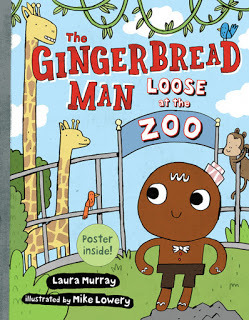
The Gingerbread Man Loose at the Zoo begins as the Gingerbread Man and his classmates are trying to solve riddles on a field trip scavenger hunt! But a zoo full of critters is a tricky place for a tasty cookie – even a very fast one. Some of the creatures find the smart cookie to be a tempting treat and he gets separated from his class. After a few narrow escapes, the Gingerbread Man meets someone else who is lost and they team up to follow the riddles to get back where they belong.
It’s so much fun for readers to be able to interact with a story. The animal riddles in the text are written so that the reader gets a chance to solve the riddle clues, before the answer is revealed by a page turn.
The first animal riddle is, “I’m spotted. I’m gentle. I’m tall as a tree. A branch full of leaves is the best snack for me. I have a new baby and she is my calf. ‘Ah-ha!’ we all shouted, ‘The answer’s… (page turn) Giraffe!’”
Each riddle in the book has many descriptors of the animal, and rhymes that help the reader predict the animal. Let your students try their hand at these riddle writing and vivid verbs activities.
A Student Riddle Writing Activity
Writing riddles is a fun way to practice skills such as prediction, researching animal attributes, and using descriptive vocabulary and vivid verbs.
Have students pick an animal and then answer these questions to come up with descriptors for that animal. This could be done as a group or individually.
· What does the animal look like? Color? Size? · Where does the animal live? Habitat? · What sound does the animal make?· What does the animal eat?· Words that describe how the animal moves.· What is the animal’s baby called?· Do you know the species of the animal?· Does the animal have personality traits? Like sneaky or stealthy?
Then students can use the descriptors to write a riddle. (The riddles don’t need to rhyme, but they can if the students happen to find a rhyme that works.)
· Here are links to two handouts with animal rhyming words if your students are interested in the challenge.
o Rhyming Animals by Ken Nesbitt
o Animal–Related Rhymes by Laura Murray
· Here is a link to the mentor text lesson with a printable student riddle idea sheet to use with the activity. http://www.lauramurraybooks.com/loose...
Using Vivid Verbs
The Gingerbread man and the animals are very active in the story. By using very vivid verbs to describe the way they move and react, it helps readers visualize the story better than ordinary verbs that aren’t very descriptive.
Here are some vivid verbs that are used in the story -
· Vivid Verbs - jumped, popped, scooped, wiggle, jiggle, zoomed, swing, glanced, scurry, screech, dodged, squeezed, waved, slurped, spied, raced, flew, snuffled, shuffled, slumped, hopped, sprang
Challenge your students to replace the common verbs listed below with vivid descriptive verbs, and then use some of those verbs in sentences / stories, or revise a piece of writing they’ve previously written.
· Ordinary Verbs – walked, saw, ran, looked, put, went, was, moved, drank, said, get, took, ate, gave, made
And here are a few more student connections that you might explore with the book: · sequencing of the animals as they appear in the story · map skills· problem solving
In the story, the Gingerbread Man knows that creative problem solving, determination, and helping others along the way, will get him where he needs to go. I hope that your students have fun with these activities and can call on these same qualities as they approach their own writing journeys.
 Laura Murray was a teacher before becoming an author and had to deal with many an escaped Gingerbread Man in her time. She is the author of the award-winning rhyming picture book series – The Gingerbread Man Loose in the School, The Gingerbread Man Loose on the Fire Truck, The Gingerbread Man Loose at Christmas, and
The Gingerbread Man Loose at the Zoo
. Laura lives with her family in northern Virginia and loves speaking at schools about reading, writing, and creating. Visit her online at http://www.LauraMurrayBooks.com and on Twitter @LauraMurrayBook.
Laura Murray was a teacher before becoming an author and had to deal with many an escaped Gingerbread Man in her time. She is the author of the award-winning rhyming picture book series – The Gingerbread Man Loose in the School, The Gingerbread Man Loose on the Fire Truck, The Gingerbread Man Loose at Christmas, and
The Gingerbread Man Loose at the Zoo
. Laura lives with her family in northern Virginia and loves speaking at schools about reading, writing, and creating. Visit her online at http://www.LauraMurrayBooks.com and on Twitter @LauraMurrayBook.
Let’s go on a scavenger hunt! With a book!
Picture books can be wonderful mentor texts for student writing skills and curriculum connections. Being a former teacher, I thoroughly enjoy writing the adventure series about a little “class-made” Gingerbread Man, but I also strive to weave fun “teachable” writing threads in the stories as well.
Here’s a bit about the Gingerbread Man’s latest adventure and a few ideas on how to use it as a writing mentor text.

The Gingerbread Man Loose at the Zoo begins as the Gingerbread Man and his classmates are trying to solve riddles on a field trip scavenger hunt! But a zoo full of critters is a tricky place for a tasty cookie – even a very fast one. Some of the creatures find the smart cookie to be a tempting treat and he gets separated from his class. After a few narrow escapes, the Gingerbread Man meets someone else who is lost and they team up to follow the riddles to get back where they belong.
It’s so much fun for readers to be able to interact with a story. The animal riddles in the text are written so that the reader gets a chance to solve the riddle clues, before the answer is revealed by a page turn.
The first animal riddle is, “I’m spotted. I’m gentle. I’m tall as a tree. A branch full of leaves is the best snack for me. I have a new baby and she is my calf. ‘Ah-ha!’ we all shouted, ‘The answer’s… (page turn) Giraffe!’”
Each riddle in the book has many descriptors of the animal, and rhymes that help the reader predict the animal. Let your students try their hand at these riddle writing and vivid verbs activities.
A Student Riddle Writing Activity
Writing riddles is a fun way to practice skills such as prediction, researching animal attributes, and using descriptive vocabulary and vivid verbs.
Have students pick an animal and then answer these questions to come up with descriptors for that animal. This could be done as a group or individually.
· What does the animal look like? Color? Size? · Where does the animal live? Habitat? · What sound does the animal make?· What does the animal eat?· Words that describe how the animal moves.· What is the animal’s baby called?· Do you know the species of the animal?· Does the animal have personality traits? Like sneaky or stealthy?
Then students can use the descriptors to write a riddle. (The riddles don’t need to rhyme, but they can if the students happen to find a rhyme that works.)
· Here are links to two handouts with animal rhyming words if your students are interested in the challenge.
o Rhyming Animals by Ken Nesbitt
o Animal–Related Rhymes by Laura Murray
· Here is a link to the mentor text lesson with a printable student riddle idea sheet to use with the activity. http://www.lauramurraybooks.com/loose...
Using Vivid Verbs
The Gingerbread man and the animals are very active in the story. By using very vivid verbs to describe the way they move and react, it helps readers visualize the story better than ordinary verbs that aren’t very descriptive.
Here are some vivid verbs that are used in the story -
· Vivid Verbs - jumped, popped, scooped, wiggle, jiggle, zoomed, swing, glanced, scurry, screech, dodged, squeezed, waved, slurped, spied, raced, flew, snuffled, shuffled, slumped, hopped, sprang
Challenge your students to replace the common verbs listed below with vivid descriptive verbs, and then use some of those verbs in sentences / stories, or revise a piece of writing they’ve previously written.
· Ordinary Verbs – walked, saw, ran, looked, put, went, was, moved, drank, said, get, took, ate, gave, made
And here are a few more student connections that you might explore with the book: · sequencing of the animals as they appear in the story · map skills· problem solving
In the story, the Gingerbread Man knows that creative problem solving, determination, and helping others along the way, will get him where he needs to go. I hope that your students have fun with these activities and can call on these same qualities as they approach their own writing journeys.
 Laura Murray was a teacher before becoming an author and had to deal with many an escaped Gingerbread Man in her time. She is the author of the award-winning rhyming picture book series – The Gingerbread Man Loose in the School, The Gingerbread Man Loose on the Fire Truck, The Gingerbread Man Loose at Christmas, and
The Gingerbread Man Loose at the Zoo
. Laura lives with her family in northern Virginia and loves speaking at schools about reading, writing, and creating. Visit her online at http://www.LauraMurrayBooks.com and on Twitter @LauraMurrayBook.
Laura Murray was a teacher before becoming an author and had to deal with many an escaped Gingerbread Man in her time. She is the author of the award-winning rhyming picture book series – The Gingerbread Man Loose in the School, The Gingerbread Man Loose on the Fire Truck, The Gingerbread Man Loose at Christmas, and
The Gingerbread Man Loose at the Zoo
. Laura lives with her family in northern Virginia and loves speaking at schools about reading, writing, and creating. Visit her online at http://www.LauraMurrayBooks.com and on Twitter @LauraMurrayBook.
Published on November 14, 2016 14:00
Mary Quattlebaum's Blog
- Mary Quattlebaum's profile
- 22 followers
Mary Quattlebaum isn't a Goodreads Author
(yet),
but they
do have a blog,
so here are some recent posts imported from
their feed.



